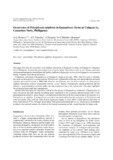Occurrence of Polysiphonia epiphytes in Kappaphycus farms at Calaguas Is., Camarines Norte, Phillippines
Share
Abstract
This paper describes the occurrence of an epiphyte infestation of Kappaphycus farms in Calaguas Is. Camarines Norte, Philippines. In particular, percentage cover of ‘goose bump’-Polysiphonia and ‘ice-ice’ disease, and some environmental parameters that influence the thallus condition of Kappaphycus alvarezii in Calaguas Is. were assessed during 3 separate visits and are discussed.
Commercial cultivation of Kappaphycus at Calaguas Is. began in the early 1990s. After five years of farming, the stock was destroyed by a strong typhoon. The area was re-planted the following year and production increased annually and reached its peak in 1998–1999. However, the following year, the first occurrence of a Polysiphonia epiphyte infestation occurred concurrently with an ‘ice-ice’ disease. Consequently, annual production and the number of seaweed planters declined rapidly, and this situation persists to the present time. This paper highlights the etiological factors and their consequences.
Results show that farm-site selection is critical for the success of Kappaphycus production. Characteristics of water movement and light intensity in farming areas contributed to the occurrence and detrimental effect of the phenomenon described as ‘goose bumps’: a morphological distortion of the host seaweed due to the presence of a Polysiphonia sp. epiphyte. A strong inverse correlation was observed between the occurrence of Polysiphonia and water movement: areas with low water motion registered a higher % cover (65%) of Polysiphonia than those in more exposed areas (17%). Although ‘goose bump’-Polysiphonia infestation and ‘ice-ice’ disease pose a tremendous problem to the seaweed farmers, the results of this limited assessment provide a useful baseline for future work.
Suggested Citation
Hurtado, A. Q., Critchley, A. T., Trespoey, A., & Lhonneur, G. Bleicher. (2006). Occurrence of Polysiphonia epiphytes in Kappaphycus farms at Calaguas Is., Camarines Norte, Phillippines. Journal of Applied Phycology , 18(3-5), 301-306. https://doi.org/10.1007/s10811-006-9032-z
Subject
Taxonomic term
Collections
- AQD Journal Articles [1249]

